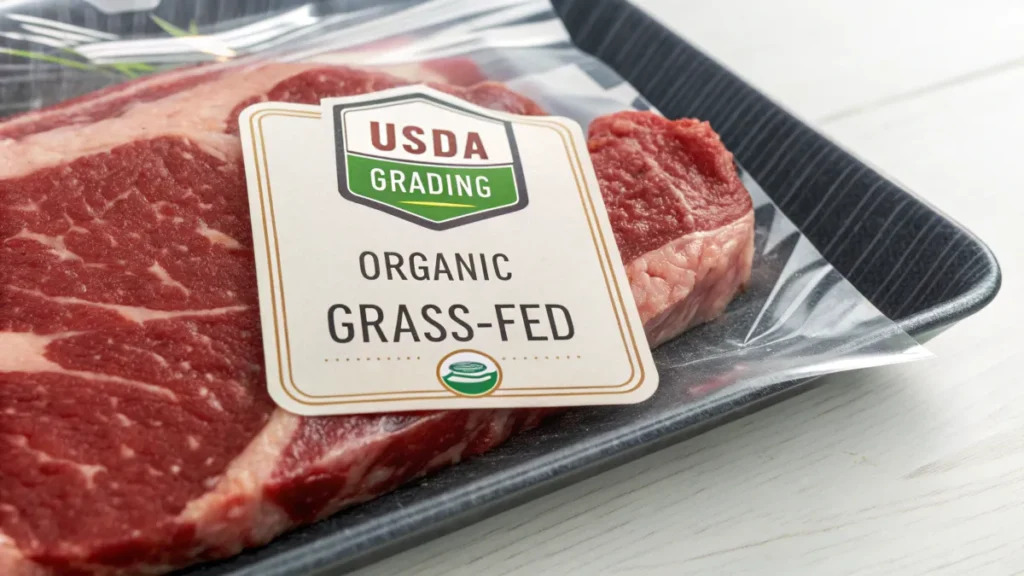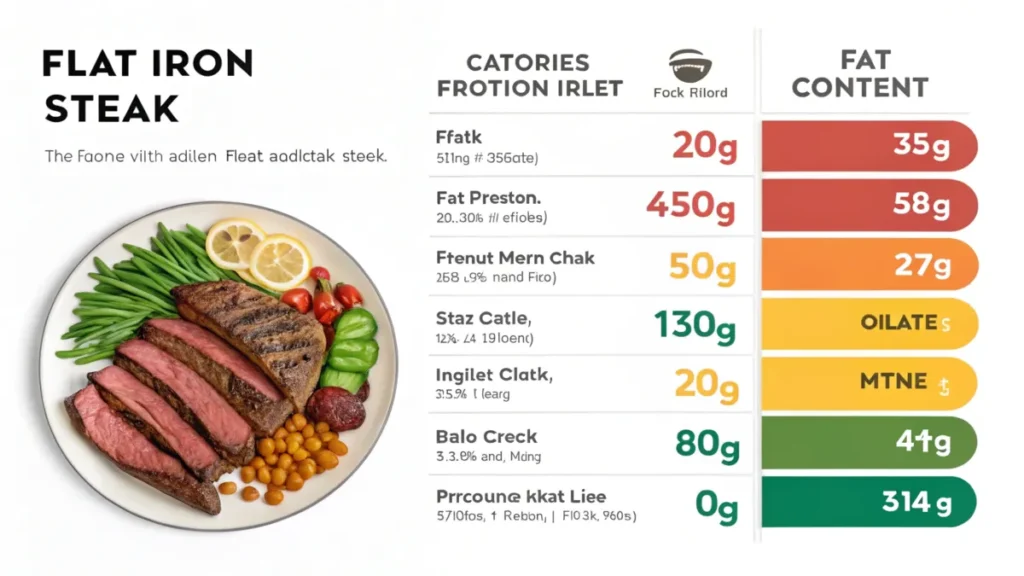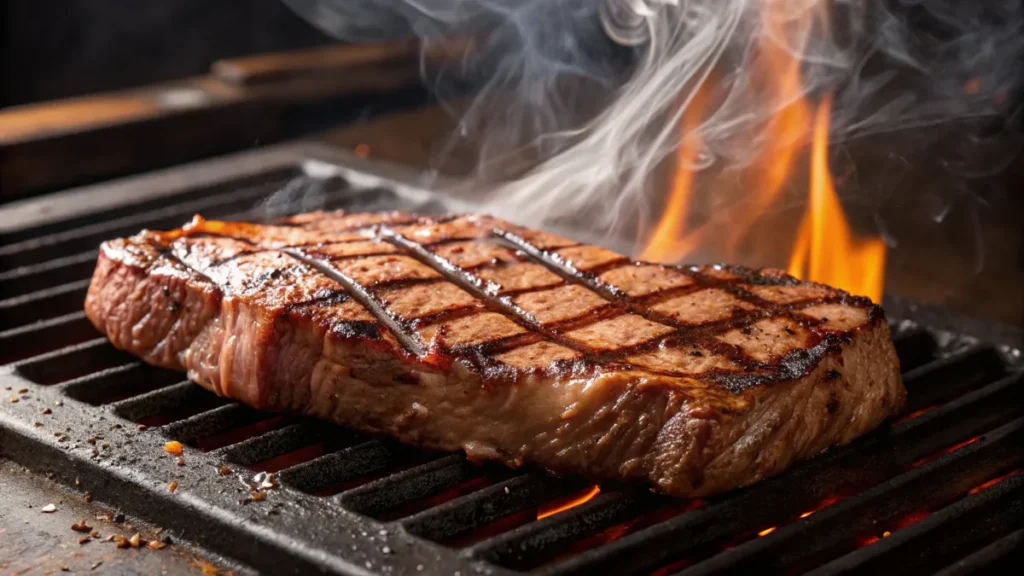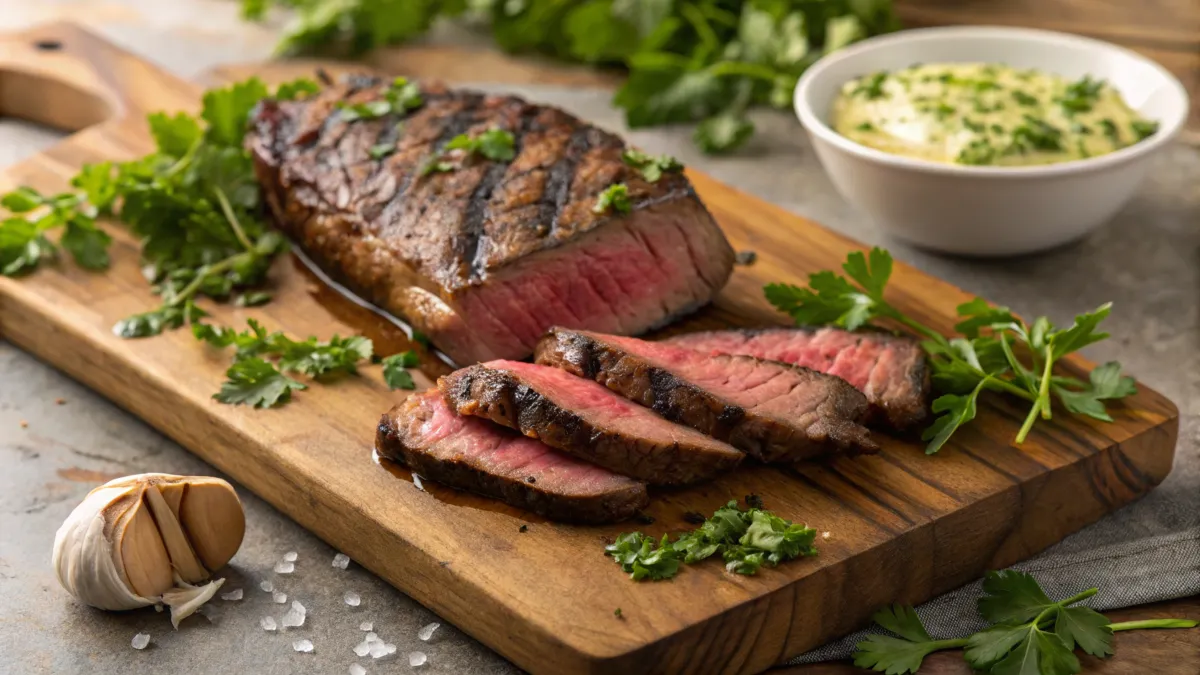Flat iron steak is one of the most flavorful and tender beef cuts, but understanding the beef loin flat iron steak label can be challenging. Whether you’re decoding USDA grades, learning about grass-fed claims, or comparing cuts, this guide provides everything you need to make informed choices. From selecting the best steak to cooking it perfectly, this article covers it all.
Understanding Beef Loin and Flat Iron Steak
What is Beef Loin?
Beef loin is a prized section of a cow that produces some of the best steak cuts. It’s located just behind the ribs and extends to the rear. Cuts from the beef loin include tenderloin, T-bone, porterhouse, and sirloin. These are known for their tenderness, flavor, and versatility in cooking.
Key Characteristics of Beef Loin:
- Found near the backbone of the animal.
- Contains highly sought-after steaks.
- Divided into two main sections: short loin and sirloin.
Each section offers unique cuts. For instance, the tenderloin is from the short loin and is famous for its buttery texture.
What is Flat Iron Steak?
Flat iron steak comes from the shoulder (or chuck) region of the cow. It’s also called a “butler steak” or “top blade steak.” Known for its deep flavor and marbled texture, it’s perfect for grilling or pan-searing.
Origins and Traits:
- Derived from the chuck primal cut, which was once overlooked.
- Developed after butchers found a way to cut around the tough connective tissue.
- Popular for its marbling, making it both tender and flavorful.
Common Uses and Recipes
Flat iron steak is versatile and often used in various dishes. Whether grilled, marinated, or sliced for stir-fry, it delivers exceptional flavor. Here are a few popular ways to enjoy it:
- Grilled flat iron steak with garlic butter.
- Pan-seared with a quick herb rub.
- Thinly sliced and served in tacos or sandwiches.
This cut is both economical and delicious, making it a favorite among steak enthusiasts.
This first part sets the stage by explaining what beef loin and flat iron steak are. In the next section, we’ll dive deeper into why labels are crucial for understanding your steak’s quality and sourcing. Stay tuned!
Why a Beef Loin Flat Iron Steak Label is Important

Why Labels Matter for Beef Consumers
When you’re shopping for beef, the label on the packaging tells you a lot about the product. It’s not just there for show it provides crucial information about quality, safety, and sourcing. For example, labels like USDA Prime, Choice, or Select let you know the grade of the beef. This helps you pick a cut that fits your recipe and budget.
Labels also ensure compliance with food safety regulations. They provide details about the meat’s origin, farming practices, and whether it’s organic or grass-fed. Knowing these details allows you to make informed choices.
How to Interpret Beef Labels
Beef labels can be overwhelming, but they’re easier to understand once you know what to look for. Key elements on a beef loin flat iron steak label include:
- USDA Grade: Indicates the level of marbling and overall quality.
- Source Information: Tells you where the beef was raised and processed.
- Nutritional Facts: Offers a quick breakdown of calories, protein, and fat content.
Additionally, claims like “no antibiotics” or “pasture-raised” give insight into how the cattle were treated. For instance, organic beef comes from cows raised without synthetic hormones or antibiotics, which some consumers prefer.
Decoding the Key Elements of a Beef Loin Flat Iron Steak Label
Label Components Explained
Every beef loin flat iron steak label includes key details that guide your purchase. Here’s what to pay attention to:
- USDA Grading: Prime beef has the most marbling, making it juicy and flavorful. Choice and Select are leaner but still tender options.
- Organic Certification: Ensures the beef is free from synthetic pesticides and antibiotics.
- Grass-Fed Claims: Beef labeled as grass-fed means the cattle were fed a natural diet, which some say enhances the flavor.
Reading these components can help you choose a steak that aligns with your values and dietary needs.
Common Misconceptions About Beef Labels
Beef labels can be confusing, and sometimes, they’re misleading. For instance, terms like “all-natural” might sound appealing but don’t necessarily mean the beef is free of additives or antibiotics. Another common myth is that grass-fed always equals better quality. While it’s healthier in some ways, taste and texture can vary depending on the cut and cooking method.
Being informed helps you navigate these claims and avoid overpaying for labels that might not add real value.
In the next part, we’ll explore the nutritional aspects of flat iron steak, comparing it to other cuts and discussing its health benefits. Stay tuned!
Based on the sitemap, no internal link directly pertains to “beef loin flat iron steak label.” However, readers interested in meat-focused recipes can check out Every Tastes Flap Meat Recipes Guide and Marble Potatoes recipes for additional cooking ideas.
Nutrition Information Found on Beef Loin Flat Iron Steak Labels

Nutritional Benefits of Flat Iron Steak
Flat iron steak is not only delicious but also packed with essential nutrients. It’s an excellent source of protein, which supports muscle growth and repair. Additionally, it contains iron and zinc, two minerals vital for energy production and immune function. A typical serving of flat iron steak delivers around 200-250 calories, depending on preparation.
This cut is relatively lean, making it a healthier option compared to fattier cuts like ribeye. The combination of great flavor and balanced nutrition makes it a versatile choice for health-conscious eaters.
Comparing Flat Iron Steak to Other Beef Cuts
When comparing flat iron steak to other cuts from the beef loin, it stands out for its tenderness and affordability. For instance:
- Tenderloin: Even more tender but pricier.
- Sirloin: Lean and flavorful but less tender than flat iron steak.
Nutritionally, flat iron steak provides similar benefits as tenderloin but at a lower cost, making it a popular choice for everyday meals. Understanding what’s on a beef loin flat iron steak label helps you identify these advantages at the store.
Recipes and Cooking Tips for Flat Iron Steak
Simple Recipes Featuring Flat Iron Steak
Cooking flat iron steak is a breeze, and it works well with various recipes. Here are a few simple and flavorful ideas:
- Grilled Flat Iron Steak: Season with salt, pepper, and garlic powder. Grill on high heat for 4-5 minutes per side for a perfect medium-rare.
- Flat Iron Steak Fajitas: Marinate with lime juice, cumin, and paprika. Slice thinly and serve with sautéed peppers and onions.
For more meat-based recipe inspiration, check out Every Tastes’ Carnitas Breakfast Recipe with Eggs.
Cooking Tips for the Perfect Flat Iron Steak
To get the best results from your flat iron steak:
- Use High Heat: Searing locks in the juices and enhances flavor.
- Let it Rest: Rest the steak for 5-10 minutes after cooking to redistribute juices.
- Slice Against the Grain: This ensures every bite is tender.
By following these tips, you can turn a simple flat iron steak into a culinary masterpiece. Pay attention to the beef loin flat iron steak label for grading and other details to ensure quality.
For more tips and recipes, dive into our collection of Marble Potatoes recipes and Texas Twinkies lovers.
In the next part, we’ll wrap up with a FAQ section to answer common questions about beef loin flat iron steak and its labels. Stay tuned!
FAQs About Beef Loin Flat Iron Steak Labels
No, flat iron steak and filet mignon are different cuts of beef. Flat iron steak comes from the shoulder (chuck) area, while filet mignon is cut from the tenderloin. Both are tender, but filet mignon is known for its buttery texture, while flat iron steak offers a richer, beefier flavor. If the beef loin flat iron steak label confuses you, look for clear terms like “chuck” or “top blade” to confirm the cut.
Beef loin cuts, like tenderloin and sirloin, are prized for their tenderness and versatility. These cuts come from the back of the cow, an area with less muscle use, making the meat softer. Flat iron steak, though not from the loin, often rivals these cuts in tenderness. Understanding terms on a beef loin flat iron steak label can help you identify similar cuts if you’re looking for tender options.
To keep flat iron steak fresh, refrigerate it within two hours of purchase. Use airtight packaging or vacuum-sealed bags to prevent moisture loss. For longer storage, freeze the steak. Proper labeling, such as the date and cut name, can make it easier to identify when you’re ready to cook.
Grass-fed flat iron steak is often seen as a healthier option because it contains higher levels of omega-3 fatty acids and antioxidants. However, both grass-fed and grain-fed options offer excellent protein and nutrients. Check the beef loin flat iron steak label for terms like “grass-fed” or “pasture-raised” if you prefer these benefits.
Comparison of Popular Steak Cuts
Here’s a quick comparison of steak cuts based on tenderness, flavor, and cost to help you choose:
| Cut | Tenderness | Flavor | Average Cost |
|---|---|---|---|
| Filet Mignon | Very tender | Mild, buttery | High |
| Flat Iron Steak | Tender | Rich, beefy | Moderate |
| Sirloin Steak | Moderately tender | Lean, flavorful | Moderate to low |
| Ribeye Steak | Moderately tender | Rich, marbled | High |
Use this table alongside the beef loin flat iron steak label to make informed decisions while shopping.
Beef labels can be confusing, but they hold valuable insights about the quality, origin, and nutrition of your steak. By understanding terms like “grass-fed,” “organic,” or “USDA Prime,” you can choose cuts that meet your taste and health needs. Whether you’re grilling flat iron steak or comparing it to other cuts, reading the beef loin flat iron steak label ensures you bring home the best option for your plate.
Comparison of Beef Grades
Understanding USDA Beef Grades
When choosing beef, the USDA grading system is your best guide to quality. The grade reflects the level of marbling (fat distribution) and overall tenderness. Reading the beef loin flat iron steak label carefully can help you identify the grade, which influences flavor, juiciness, and price.
Detailed Comparison of Beef Grades
Here’s a helpful table that breaks down the most common beef grades:
| USDA Grade | Marbling Level | Tenderness | Common Uses |
|---|---|---|---|
| Prime | High | Exceptionally tender | Fine dining and grilling |
| Choice | Moderate | Very tender | Everyday cooking |
| Select | Low | Lean and firm | Budget-friendly recipes |
Each grade suits different cooking styles. For instance, a Prime flat iron steak is ideal for grilling, while Choice works well in stir-fries or slow-cooked dishes. Pay attention to the beef loin flat iron steak label to ensure you select the right grade for your needs.
Key Takeaways from This Guide
Decoding a beef loin flat iron steak label might seem daunting, but it’s simpler when you know what to look for. Labels contain essential information about the cut, grade, and source of the beef, helping you make informed choices. Whether it’s USDA grading, grass-fed claims, or nutritional details, these elements ensure you get the best value and quality for your money.
Encouragement to Explore More
By understanding the terms on beef labels, you can choose steaks that align with your cooking preferences and dietary needs. Whether grilling a flat iron steak or experimenting with other cuts, always check the label for grading and freshness. If you’re inspired to try new recipes, consider exploring more ideas like EveryTastes’ Carnivore Dinner Recipes for Meat Lovers for creative ways to enjoy your beef.
This article is your guide to mastering beef labels. Use it to navigate the grocery store with confidence and elevate your next meal with the perfect flat iron steak.
Tips for Buying Flat Iron Steak
Choosing Fresh and High-Quality Cuts
When purchasing flat iron steak, look for bright red meat with minimal discoloration. The beef loin flat iron steak label often indicates packaging and processing dates, which help ensure freshness. Avoid cuts with excessive liquid in the packaging, as it may indicate a loss of quality.
Spotting Sustainable and Ethical Options
Sustainability is becoming a priority for many shoppers. Look for labels like “Certified Humane” or “Grass-Fed” to support ethical farming practices.
Cooking Methods for Flat Iron Steak

Best Cooking Techniques for Flat Iron Steak
Flat iron steak is versatile and cooks beautifully with high-heat methods. Popular techniques include grilling, pan-searing, and broiling. Each method enhances the steak’s rich flavor while maintaining its tenderness.
Avoiding Common Cooking Mistakes
Overcooking can make flat iron steak tough. Keep an eye on internal temperatures, aiming for medium-rare to medium for the best texture. Using meat thermometers ensures precision, especially when trying recipes from reputable sources like Food Network’s Grilling Guides.
Mastering Beef Labels for Better Meals
Understanding the beef loin flat iron steak label is your first step toward enjoying flavorful and high-quality meals. From USDA grades to cooking tips, this guide has covered everything you need to make informed decisions. Whether you’re buying fresh cuts, exploring cooking techniques, or comparing grades, remember to rely on trusted labels and guides. Explore related recipes and enjoy experimenting with your flat iron steak for memorable dining experiences.

